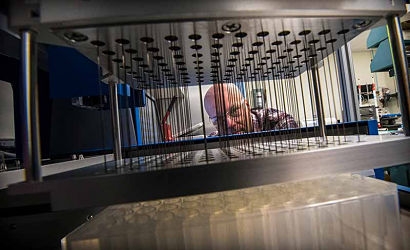
A new paper, “Engineering enhanced cellobiohydrolase activity”, published in Nature Communications describes NREL’s long-running study of fungal cellobiohydrolases (CBHs) – enzymes that use hydrolysis as their main chemistry to degrade celluslose. Ten years of research has enabled the team to gain a better understanding of the structure-activity relationships of Trichoderma reesei (TrCel7A) and Penicillium funiculosum (PfCel7A) in order to predict the best places to make changes and improvements.
In both nature and industrial processes, enzymes from CBH family are among the most significant enzymes for breaking down cellulose. A projected 2,000-ton-per-day cellulosic ethanol plant could potentially use up to 5,000 tons of enzyme per year, and half of that enzyme cocktail could be from this enzyme family.
“There’s been a drive over the last several decades of trying to understand and improve biocatalysts from this key enzyme family” said Gregg Beckham, group leader at NREL and senior author of the study. “The more efficient the enzyme, the less enzyme used, and thus the process is cheaper. However, we still have a long way to go to be able to make enhancements in a predictive capacity.”
In 2005, NREL researchers Mike Himmel, Steve Decker, and Bill Adney discovered a CBH from a different fungus, PfCel7A, and found that it performs 60 percent better than TrCel7A. This was found to be much better than the industry standard, so the team ran a lot of experiments to ensure that the activity was real. They then started to ask themselves why it was better. An understanding of the structural differences could potentially be used to engineer better enzymes. This in turn could help reduce the cost of cellulosic biofuel and biochemical production. The NREL team spent several more years to develop the tools to identify a couple of hot spots that could be modified to make the enzymes perform better.
The discovery unfolded as NREL took a close look at the similarities between TrCel7A and PfCel7A and then worked to isolate the differences. Both enzymes have a three-domain architecture: the carbohydrate binding molecule that attaches it to cellulose; the catalytic domain that breaks down cellulose; and the link that connects these two domains together. The research team then conducted domain swapping experiments by creating a chimera library, which is a collection of mutant enzymes created from the two parent enzymes.
“With three domains between two parents, that makes eight combinations in total” said Beckham. “We tested the various combinations to find out which area is providing the enzyme with better performance, and perhaps not surprisingly, in hindsight, it’s the catalytic domain.”
With those findings, the researchers then compared the catalytic domains of TrCel7A and PfCel7A and found eight areas that were different. Continuing to narrow down the possibilities, the team took the TrCel7A parent and made modifications, one at a time, in those eight areas and uncovered two important modifications that resulted in TrCel7A performing almost to the level of the PfCel7A parent. These two changes doubled the performance of TrCel7a. This shows that very minor changes can be modified to dramatically affect the performance of the enzyme, making it capable of breaking down cellulose faster and thus allowing industrial processes to use less enzyme.
The NREL team’s ultimate aim is to help other researchers sift through the mountain of genomics data to find better enzymes, based on their genetic sequence alone. The work reported in Nature Communications was funded by the Energy Department’s Bioenergy Technologies Office. A patent application has been filed on this research, and the NREL Technology Transfer Office will be working with researchers to identify potential licensees of the technology.
Image: Part of the research team that discovered specific regions on enzymes that help break down cellulose faster, NREL scientist Markus Alahuhta prepares plates to obtain protein crystals for structural determination. (Photo by Dennis Schroeder / NREL)
For additional information:

